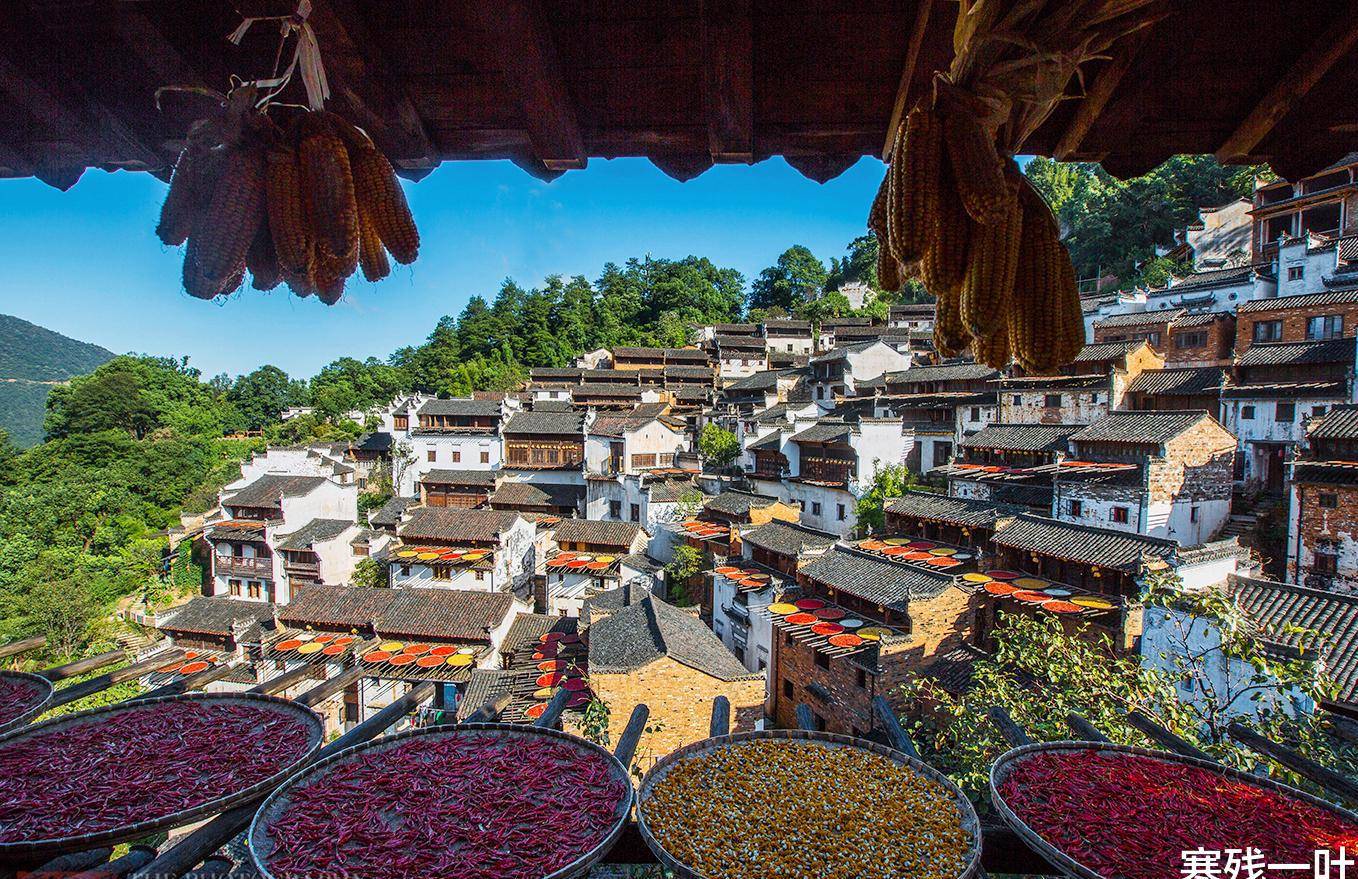Huangling, people know it all from the colorful photos, full of harvest scenes. “Shaiqiu Family” has also become a business card of Huangling, Wuyuan, Jiangxi. Huangling Ancient Village was founded by Cao Wenkan in the Xuande period of the Ming Dynasty and has a history of more than 500 years. Adhering to the legacy of the ancestors, the ancestors of Huangling used to use a peaceful mind to communicate with the rugged terrain of “no three feet flat”. They used bamboo sieve plaques to dry crops in front of the windowsill, which did not occupy space and was convenient for storage.
Nowadays, “Huangling sun drying in autumn” has become a fixed custom. Every autumn harvest season, every household’s eaves are covered with brightly colored agricultural products such as corn and peppers. It forms a perfect autumn harvest picture with the Hui-style houses with white walls and black tiles. Called “the most beautiful Chinese symbol”.
Taken in Huangling Village, Wuyuan, Jiangxi.
The Huangling Scenic Area in Wuyuan is a typical mountain village, and the houses are scattered in fan-shaped ladders. Huangling is well-known for its “sun in autumn”. The “Tianjie” in the village is like a jade belt that connects classic ancient buildings, and there are many Hui-style shops, and a flowing abbreviated version of “The Riverside Picture on Qingming Festival”. Surrounded by thousands of ancient trees and tens of thousands of acres of terraced fields, the sea of flowers in the four seasons displays stunning land art. The ancient village of Huangling was built on the hillside, surrounded by ancient trees. The back mountain is dominated by green pine. The shuikou forest at the foot of the village is dominated by the yew group. After the cable car is the shuikou forest into the village, most of the trees are fragrant maple and ancient camphor. Most of them are several hundred years old, and the longest is over a thousand years. These trees tell you how long the history of the village is. The well-preserved Hui-style ancient village pattern in Huangling has the original ancient village style and folk customs. The house structure of the village is special. The front door of the first floor of the farmhouse is facing the main road; the second floor of the household can reach higher places. On the other main road, the front door on the second floor is built up and down, which is connected with the horizontal wooden frame built outside the house to dry the agricultural products. This solves the contradiction between building villages on slopes and drying crops without flat areas. Bamboo drying is used for drying crops, which does not occupy space and is convenient for storage. Every year during the harvest season, the houses become a world of sunburn, and the colorful crops and black roofs overlap each other, which is spectacular. Autumn is the season of rich colors. Golden corn and hot red peppers fill the whole house. The aunts are really busy connecting the farming to make it easier to dry. These gorgeous colors make Huangling in autumn more abundant and “very charming.” As night fell, the lights were turned on in every household in the village. The lively small mountain village full of tourists during the day has returned to its original nature and suddenly became quiet. The owner of the two dried peppers under the eaves guessed that they would be busy eating, and forgot them here. Fortunately, the eaves can block rain and dew, so that they won’t get wet by night dew. After dinner, I walked away, and the streets full of tourists during the day became empty. The night here is so quiet, so quiet that I can only hear my own footsteps, so quiet that people forget the trivialities of the world, and it’s so quiet that people feel a little flustered… The originally rough bluestone slab became smooth and round after years of polishing. These exquisitely crafted and luxuriously decorated old houses, after hundreds of years of ups and downs, still stand here, and they have changed owners several times. The former owner here spent a lot of effort to build this luxurious mansion, but the precious wealth he left for future generations is not only material, but more spiritual. These buildings can survive for hundreds or even thousands of years. Thinking about the buildings we have built now…well, I seem to be thinking too much. Travel information: Airplane: There is currently no airport in Wuyuan. There are airports in surrounding cities such as Jingdezhen, Huangshan, Quzhou, and Nanchang. Jingdezhen Airport and Huangshan Airport are relatively close to Wuyuan. Jingdezhen Luojia Airport is about 80 kilometers away from Wuyuan County. It is the nearest airport to Wuyuan, and it is more convenient to arrive by air. Self-driving: To the east of Quzhou: From Quzhou to Wuyuan, you can take the Shanghai-Kunming Expressway-205 National Road-Huabai Line-Dewu Expressway. The whole journey is about 150 kilometers and takes about 2.5 hours. To the south of Shangrao: From Shangrao to Wuyuan, you can take Deshang Expressway-Dechang Expressway-Dewu Expressway. The whole journey is about 140 kilometers and takes about 2.5 hours. To the west of Jingdezhen: From Jingdezhen to Wuyuan, you can take the Hangrui Expressway. The whole journey is about 85 kilometers and takes about 1 hour. To the north of Huangshan: From Huangshan City to Wuyuan, you can take the Hangrui Expressway. The whole journey is about 100 kilometers and takes about 1 hour

You must log in to post a comment.